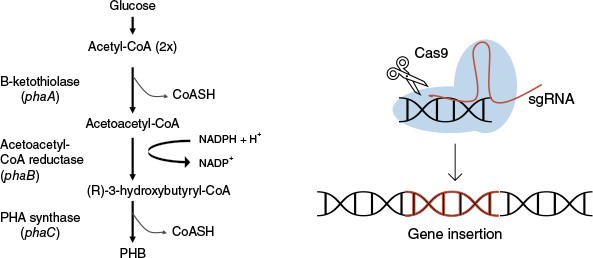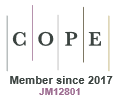Bio-based plastics – a sustainable solution to plastic pollution
Arturo Aburto Medina A * , Soulayma Hassan A , Chaitali Dekiwadia B , Chengrong Chen C D and Andrew S. Ball A DA
B
C
D

Dr Arturo Aburto Medina obtained his PhD from the University of Essex, UK, and has more than 10 years’ experience conducting research and consulting on diverse bioremediation and environmental projects. He has conducted postdoctoral studies at the University of California—Irvine, Flinders University and RMIT University. His research interests include bioremediation of contaminated sites, antimicrobial surfaces, conservation of the environment and indoor air quality. ORCID: https://orcid.org/0000-0002-2871-609X. |

Soulayma Hassan is a PhD candidate at RMIT University, Australia. Her research focuses on the sustainable production of polyhydroxyalkanoates (PHAs) from lignocellulosic biomass, particularly sugarcane bagasse, aiming to develop cost-effective and eco-friendly bioplastics. Her research interests include the circular economy, sustainable resource management and waste valourisation. Soulayma’s research experience also extends to the anaerobic digestion of organic waste, further promoting waste-to-resource technologies. ORCID: https://orcid.org/0009-0009-8839-2611. |

Dr Chaitali Dekiwadia is a platform scientist at RMIT’s Microscopy & Microanalysis Facility. She has conducted postdoctoral studies at The University of Melbourne and Peter MacCallum Cancer Centre. She specialises in life sciences, cryo and X-ray CT, with a passion for advancing research through cutting-edge technology. Her deep knowledge of electron microscopy as a core facility staff for cross discipline collaboration has significantly contributed to produce good research outcomes, fostering technical excellence and enhancing scientific collaboration. ORCID: https://orcid.org/0000-0002-0928-4420. |

Prof. Chengrong Chen is distinguished professor in environmental biogeochemistry and waste recycling at Griffith University and research director of the Solving Plastic Waste CRC. Over the past 30 years, Prof. Chen has worked in the areas of environmental biogeochemistry, with a broad interest in waste recycling, climate change, decarbonation and environmental pollution and sustainability. He has published over 200 peer-reviewed journal papers. ORCID: https://orcid.org/0000-0001-6377-4001. |

Andrew S. Ball is the director of the ARC Training Centre for the Transformation of Australia’s Biosolids Resource, a distinguished professor at RMIT University, Melbourne, and Solving Plastic Waste CRC program leader. He has worked in the areas of soil microbiology, environmental pollution and biogeochemical cycling for 40 years, publishing over 300 peer-reviewed articles. ORCID: https://orcid.org/0000-0003-2387-968X. |
Abstract
Global annual plastic production is >410 × 106 tonnes with an annual rate increase of 4%; most of this plastic is non-biodegradable. Bio-based plastics (also known as bioplastics) are formed from polymers created from renewable or recycled raw materials, making them part of a sustainable plastic life cycle and part of a circular economy. Their production uses carbon-neutral energy and products are recycled at their end of life (EOL). Thus, they stand as an alternative to the current global plastic waste problem (>80% goes to landfill). Bio-based plastics can have a lower carbon footprint than conventional plastics, their materials properties can be advantageous, they are compatible with current recycling streams and biodegradation as EOL is also an option for some. Some challenges include having a larger production of bio-based plastics by gene-edited microorganisms and an improvement in the chemical and biological methods of recycling (upcycling) to process larger volumes and create higher-quality materials. Also, policy is important for the clear identification of bio-based plastics and their acceptance by creating financial incentives for their upscaling.
Keywords: bio-based plastics, biological recycling, carbon-neutral energy, circular economy, PHAs, polyhydroxyalkanoates, polyhydroxylalkanoic acids, renewable sources.
Introduction
Global annual plastic production is >410 × 106 tonnes with an annual rate increase of 4%.1 Thus, plastic constitutes the third highest waste source globally making it a huge human health and environmental concern.2 Most of this plastic is non-biodegradable. Polyethylene terephthalate (PET) is the dominant material (production of 70%) in the global fibres market, whereas polyethylene (PE; 36%), polypropylene (PP; 21%) and polyvinylchloride (PVC; 12%) are the main non-fibre plastics produced.3 The largest global plastic volumes are used in the following commercial sectors: packaging (35%), construction (16%), textiles (14.5%), consumer goods (10.3%), automotive (10.1%), electronics (6.2%) and agricultural industries (3.4%). Packaging is the main source of waste, with 141 × 106 tonnes produced in 2015 alone, of which 96.6% was unrecycled.3 A significant portion of non-biodegradable plastic end up in the environment. It is estimated that up to 80% of plastics found in oceans comes from the land4 and ~2 × 106 tonnes of plastic debris leach into rivers annually3 in both developing and developed nations. Moreover, wealthier nations ship their waste to developing countries with inferior regulations and waste management infrastructure.5 Malaysia has been the world’s largest importer of plastic waste2 and also has one of the largest plastic production industries globally; however, along with other developing nations in South-east Asia, Malaysia lacks appropriate waste management systems.6 Up to 85% of the plastic waste ends up in landfill and the marine environment.7 This waste is harmful because microplastics (<1–5 mm) are generated and consumed by marine organisms resulting in bioaccumulation and biomagnification. Today, microplastics has been reported to be detected in air, tap water, fish and salt.8 Microplastics can also absorb and carry contaminants (e.g. hydrophobic organic chemicals).9 In addition, plastic can leach oestrogenic-like chemicals (e.g. bisphenol A) when exposed to sunlight or certain temperatures that may result in metabolic disorders in mammals such as obesity and type-2 diabetes.10
Plastic pollution is also very costly; the impact on tourism, fishing and shipping industries is estimated to be US$1.3 × 109 year–1 in the Asia–Pacific region alone.11 The Malaysian government has established a roadmap to zero single-use plastic 2018–3012 joining other nations with similar measures such as New Zealand, Thailand, India and the European Union.
Bio-based plastics and the circular economy
Not all bio-based plastics are environmentally degradable; however, bio-polybutylene succinate (bioPBS), polylactic acid (PLA), polyglycolic acid (PGA) and polyhydroxyalkanoates (PHAs) are, with low carbon, biodegradable and compostable (industrial composting) options available (Table 1).
| Polymer | Biodegradation (industrial) | Biodegradation (ocean) | Price (US$ kg–1) | Global production (%) | |
|---|---|---|---|---|---|
| Fossil-based and durable | |||||
| HDPE | Non-biodegradable | Non-biodegradable | 1.4–1.6 | 12.5 | |
| LDPE | Non-biodegradable | Non-biodegradable | 1.36 | 14.4 | |
| PP | Non-biodegradable | Non-biodegradable | 1.1 | 19.3 | |
| PS | Non-biodegradable | Non-biodegradable | 0.7–1.5 | 5.3 | |
| PET | Non-biodegradable | Non-biodegradable | 1.2–1.4 | 6.2 | |
| PVC | Non-biodegradable | Non-biodegradable | 1.9 | 12.9 | |
| Fossil-based and degradable | |||||
| PBAT | 2–3 months | >1 year | 4.1 | 7.1 | |
| PBS | 2–5 months | >1 year | 4.5 | ||
| PVA | 1–2 weeks | 4 months | 2 | ||
| PCL | 4–6 weeks | 6 weeks | NA | ||
| Bio-based and durable | |||||
| PEF | 9 months | NA | NA | 1.5 | |
| bioPET | No | NA | NA | ||
| bioPE | No | NA | 1.8–2.4 | ||
| Bio-based and degradable | |||||
| bioPBS | >3 months | >1 year | NA | ||
| PLA | 6–9 weeks | >1.5 years | 2–3 | ||
| PGA | 2–3 months | 1–2 months | NA | ||
| P3HB | 1–4 months | 1–6 months | 3–8 | ||
| P4HB | 4–6 weeks | 1–6 months | 3–8 | ||
Global production data are from Plastics Europe.13 HDPE, high-density polyethylene; LDPE, low-density polyethylene; NA, not available; P3HB, poly(3-hydroxybutyrate); P4HB, poly(4-hydroxybutyrate); PBAT, polybutylene adipate-co-terephthalate; PBS, polybutylene succinate; PCL, polycaprolactone; PE, polyethylene; PEF, polyethylene furanoate; PET, polyethylene terephthalate; PGA, polyglycolic acid; PLA, polylactic acid; PP, polypropylene; PS, polystyrene; PVA, polyvinyl alcohol; PVC, polyvinylchloride.
Global plastic production is dominated by fossil-based and durable plastics, PP being the largest produced (Table 1). Such plastics are largely responsible for the global plastic and microplastic problem. Research has been conducted on their degradation by microorganisms.14 A recent review has listed bacteria, fungi, engineered microorganisms, microbial consortia, algae and animals capable of degrading conventional plastics.15 However, such an approach is likely to represent just one alternative among several to the microplastic problem considering the increasing volume of conventional plastics produced every year (>410 × 106 tonnes).
Ideally, bio-based plastics should be made from renewable or recycled sources to comply for a circular economy and be part of a sustainable plastic life cycle (where waste becomes raw material). In the current linear economy, only 9% are recycled, 12% incinerated, with the remainder sent to landfill.3 A circular economy approach has been proposed to be able to reduce greenhouse gas emissions by ~62%.16 Some of the renewable sources include lignocellulosic biomass such as wheat straw and sugarcane bagasse,17 which are cheap, although they do require a pretreatment to obtain the fermentable cellulose and hemicellulose sugars.18
Bio-based plastic production
Global bio-based plastic production has more than doubled since 2010.19 Close to half of the 2.18 × 106 tonnes of bioplastics manufactured in 2023 was for packaging, the most prevalent type of plastic pollution. The uptake of bioplastics (~1%) used in Australia is currently limited by high production costs, with most bioplastics in Australia imported from Thailand and Brazil. However, the commercial market of PHAs has been estimated to reach annual volumes of 100,000 tonnes in future years.3 Bio-based and degradable polyesters are PLA, bioPBS and PHAs (Fig. 1); all have the advantage of being able to be cleaved by enzymatic activity or hydrolysis.
Chemical structures of polylactic acid (PLA), polybutylene succinate (PBS) and polyhydroxyalkanoate (PHA).
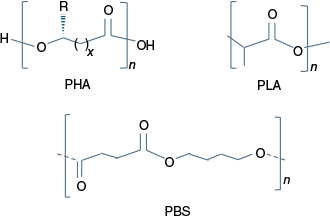
PHAs can be produced by a range of different bacteria (Fig. 2a) including Bacillus safensis,20 Cupriavidus necator,21 and archaeal strains Haloferax mediterranei22 and Halogeometricum borinquense.23
(a) Fluorescent Nile red staining of cells accumulating polyhydroxylalkanoic acids (PHAs) on agar plates. (b) Transmission Electron Microscopy image showing intracellular PHA production (white granules) by one of RMIT University’s isolates from rotted sugar cane bagasse.
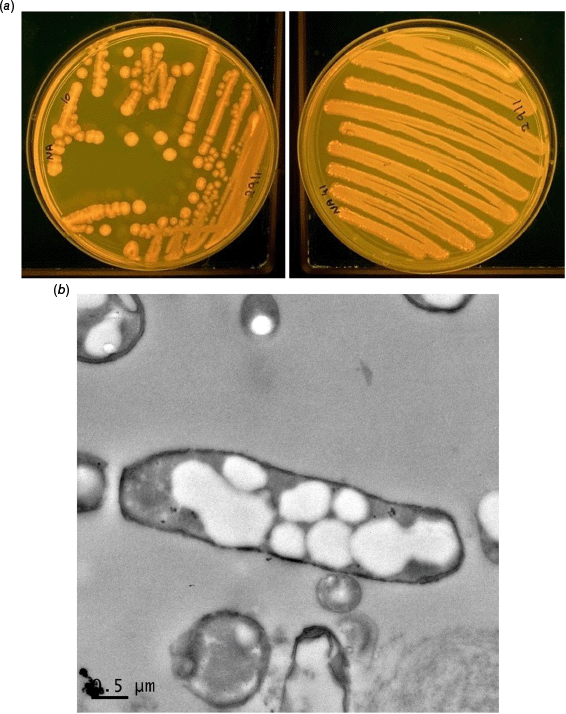
PHA is stored intracellularly, representing up to 80% of their cell volume (Fig. 2b). PHA can be synthesised from biomass compounds, e.g. sugar cane bagasse or liquefied plastic wastes24 (Fig. 1). The most common monomers consist of the rigid poly-3-hydroxybutyrate (P3HB) and the softer and more flexible poly-(3-hydroxybutyrate-co-3-hydroxyhexanoate) (PHBH), making them good substitutes for PE and PP.25 The key enzymes and steps involved in PHA production are 3-ketothiolase: acetyl coenzyme A (CoA) to acetoacetyl CoA and PHA synthases that polymerise hydroxyacyl-CoA monomers to form polymeric PHA chains. Research is currently aimed at enhancing PHA yields by increasing the cell size (Fig. 3) along with improving stress tolerance26 through the application of CRISPR-Cas9 approaches. Further, more environmentally friendly processes for cell extraction are also being developed.26,27
Recycling of plastics
To be part of a complete circular economy, bioplastics should undergo biological recycling through aerobic composting or anaerobic degradation at their end of life (EOL), whereas fossil-based plastics should be upcycled by chemical or biological depolymerisation or by undergoing thermolysis for those with functional (PET) and non-functional backbones (PE and PP) respectively (Fig. 4).
A circular plastic economy. Plastic waste becomes raw material to be recycled. Composting or incineration of captured methane from anaerobic digestion is a net-zero addition to the carbon cycle since it is captured by photosynthesis to create new biomass.
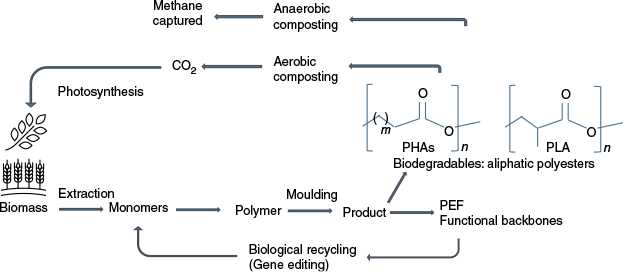
Fate of bioplastics at EOL
Composting and biodegradation involve the microbial digestion of the polymeric material in oxic conditions into CO2 and H2O by known strains.28 The process can be aided by fragmentation and the reduction of particle size making it more susceptible to enzymatic degradation.29 Hydrolysis and photodegradation can also help, but oxo-degradation (oxidation) is not recommended due to microplastic formation. Biodegradation is not guaranteed because it is highly dependent on the polymer’s chemical structure, the environment and the microorganisms available30 and all these conditions may not be met even in industrial composters. Composting times vary according to the polymer composition and can go up to 9 months for polyethylene furanoate (PEF) (Table 1).
The advantage of anaerobic digestion is the net-zero carbon balance for the bioplastic waste while producing energy from the capture and burning of the produced methane and when water is circulated to promote microbial activities, a bioreactor landfill can be created increasing its efficiency. This EOL is ideal for PHAs and would be recommended over other EOLs such as biodegradation, chemical or biological recycling.
Fate of fossil-based plastics at EOL
The cheapest form and most common form of recycling and requires sorting the polymer types, washing, mechanical shredding, melting and forming new plastic shapes. The new plastics are generally of lower quality due to thermal and mechanical stress and virgin polymers may be added to increase the product quality.31 Some non-recyclable items include medical contaminants, coloured or low-density materials. The environmental impact of mechanical recycling is lower than producing virgin plastics but only 10% of PET and high-density PE is recycled globally.32 The recycling rate can be increased with deposit-refund schemes for post-consumer plastics as is the case in Norway and Germany where >97% of PET bottles are recycled.
Chemical recycling has also been termed upcycling and can generate high-quality polymers from waste as opposed to mechanical recycling. Depolymerisation is performed by solvolysis and thermolysis, and it can convert the polymers into materials of high quality.31 However, it is more expensive and only accounts for <1% of all recycled plastics. Thus, a challenge for chemical companies is to make this process cost competitive with virgin polymers. Although the thermolysis of polystyrene can recover >90% of liquid hydrocarbon oil,33 there is the risk of potential toxic gases production due to additives.
Microorganisms are used to depolymerase polymers into monomers but do not digest them to CO2. Although aromatic polyesters are more resistant to enzymatic hydrolysis, the bacterium Ideonella sakaiensis can depolymerise PET at ambient temperatures in just 40 days.29 Genetic modification has also been used to improve the depolymerisation of PET and PEF.14,34
Policy
The plastic waste pollution is one of current three most pressing global environmental crises. Solving plastic waste problem cannot be achieved without evidence-based government policy intervention. The circular economy of plastic is being prioritised by governments and international bodies. The United Nations has made it a priority since 2018. The Ellen McArthur Foundation promotes science-based policies for a circular economy.35 The European Union aims to recycle 50% of plastic packaging by 2030 and certain items of single-use plastic have been banned. The adoption of extended producer responsibility (EPR) schemes has helped local governments deal with packaging materials, but the scope needs to include other plastic industries. Household waste management systems should be implemented globally as has been initiated in some European countries and Japan.36 China has plans to increase their bioplastics production, specifically PLA and ban all non-recyclables whereas Japan, Malaysia, Singapore and South Korea have created bioplastic subsidies.37 Recent discussion of introduction of recycled content in plastic products is encouraging and adoption of government policy shift will certainly enhance the recycling of plastic and reduce the problem of plastic pollution in the environment.
Conclusions
Bio-based plastics have the potential to create a circular economy and gene editing is very promising not only to increase bioplastic polymerisation (especially for PHAs), but also for biological depolymerisation during recycling. Moreover, public education on bioplastics needs to increase and labels need to be standardised for local and global scales to prevent confusion and avoid ‘greenwashing’. Deposit-refund systems for plastic bottles should be implemented globally and mimic the successful EU cases. Policies such as taxation of non-bio-based plastics should increase the demand for bioplastics and promote a more circular economy.
References
1 Plastics Europe (2025) Plastics – the fast Facts 2024. Plastics Europe, Brussels, Belgium. https://plasticseurope.org/knowledge-hub/plastics-the-fast-facts-2024/
2 Chen HL et al. (2021) The plastic waste problem in Malaysia: management, recycling and disposal of local and global plastic waste. SN Appl Sci 3, 437.
| Crossref | Google Scholar |
3 Rosenboom J-G et al. (2022) Bioplastics for a circular economy. Nat Rev Mater 7, 117-137.
| Crossref | Google Scholar | PubMed |
4 Jambeck JR et al. (2015) Plastic waste inputs from land into the ocean. Science 347, 768-771.
| Crossref | Google Scholar | PubMed |
5 Kitt JR (1994) Waste exports to the developing world: a global response. Geo Int’l Envtl L Rev 7, 485.
| Google Scholar |
6 Tan E et al. (2022) A review of plastic and microplastic pollution towards the Malaysian marine environment. IOP Conf Ser Earth Environ Sci 1013, 012012.
| Crossref | Google Scholar |
7 Fauziah SH et al. (2021) Marine debris in Malaysia: a review on the pollution intensity and mitigating measures. Mar Pollut Bull 167, 112258.
| Crossref | Google Scholar | PubMed |
8 World Health Organization (2019) National systems to support drinking-water: sanitation and hygiene: global status report 2019. UN-Water global analysis and assessment of sanitation and drinking-water, GLAAS 2019 report. WHO, Geneva, Switzerland. https://www.unwater.org/sites/default/files/app/uploads/2020/04/UN-Water-Global-Analysis-and-Assessment-of-Sanitation-and-Drinking-Water-GLAAS_2019_eng.pdf
9 Ziccardi LM et al. (2016) Microplastics as vectors for bioaccumulation of hydrophobic organic chemicals in the marine environment: a state-of-the-science review. Environ Toxicol Chem 35, 1667-1676.
| Crossref | Google Scholar | PubMed |
10 Yang CZ et al. (2011) Most plastic products release estrogenic chemicals: a potential health problem that can be solved. Environ Health Perspect 119, 989-996.
| Crossref | Google Scholar | PubMed |
11 Messerli P et al. (2019) The future is now – science for achieving sustainable development. Global sustainable development report 2019. United Nations, New York, NY, USA. https://sustainabledevelopment.un.org/content/documents/24797GSDR_report_2019.pdf
12 Ma ZF et al. (2020) Microplastic pollution and health and relevance to the Malaysia’s roadmap to zero single-use plastics 2018–2030. Malays J Med Sci 27, 1-6.
| Crossref | Google Scholar | PubMed |
13 Plastics Europe (2025) Plastics – the Facts 2022. Plastics Europe, Brussels, Belgium. https://plasticseurope.org/knowledge-hub/plastics-the-facts-2022/
14 Tournier V et al. (2020) An engineered PET depolymerase to break down and recycle plastic bottles. Nature 580, 216-219.
| Crossref | Google Scholar | PubMed |
15 Wu Z et al. (2023) Biodegradation of conventional plastics: candidate organisms and potential mechanisms. Sci Total Environ 885, 163908.
| Crossref | Google Scholar |
16 Zheng J, Suh S (2019) Strategies to reduce the global carbon footprint of plastics. Nat Clim Chang 9, 374-378.
| Crossref | Google Scholar |
17 Hassan S et al. (2024) Valorisation of sugarcane bagasse for the sustainable production of polyhydroxyalkanoates. Sustainability 16, 2200.
| Crossref | Google Scholar |
18 Questell-Santiago YM et al. (2020) Stabilization strategies in biomass depolymerization using chemical functionalization. Nat Rev Chem 4, 311-330.
| Crossref | Google Scholar | PubMed |
19 Kikken N (2024) CSIRO report reveals the state of bioplastics in Australia. News Release, 5 December 2024. CSIRO.https://www.csiro.au/en/news/all/news/2024/december/csiro-report-reveals-the-state-of-bioplastics-in-australia
20 Madhumathi R et al. (2016) Optimization of polyhydroxybutyrate production by Bacillus safensis EBT1. Clean – Soil, Air, Water 44, 1066-1074.
| Crossref | Google Scholar |
21 Berezina N (2013) Novel approach for productivity enhancement of polyhydroxyalkanoates (PHA) production by Cupriavidus necator DSM 545. N Biotechnol 30, 192-195.
| Crossref | Google Scholar | PubMed |
22 Koller M, Rittmann SKMR (2022) Haloarchaea as emerging big players in future polyhydroxyalkanoate bioproduction: review of trends and perspectives. Curr Res Biotechnol 4, 377-391.
| Crossref | Google Scholar |
23 Salgaonkar BB, Bragança JM (2015) Biosynthesis of poly(3-hydroxybutyrate-co-3-hydroxyvalerate) by Halogeometricum borinquense strain E3. Int J Biol Macromol 78, 339-346.
| Crossref | Google Scholar | PubMed |
24 Medeiros Garcia Alcântara J et al. (2020) Current trends in the production of biodegradable bioplastics: the case of polyhydroxyalkanoates. Biotechnol Adv 42, 107582.
| Crossref | Google Scholar | PubMed |
25 Hann S et al. (2020) Biobased and biodegradable plastics in Denmark. Ind Biotechnol 16, 164-175.
| Crossref | Google Scholar |
26 Li D et al. (2017) Controlling microbial PHB synthesis via CRISPRi. Appl Microbiol Biotechnol 101, 5861-5867.
| Crossref | Google Scholar | PubMed |
27 Vu DH et al. (2020) Recycling strategies for polyhydroxyalkanoate-based waste materials: an overview. Bioresour Technol 298, 122393.
| Crossref | Google Scholar | PubMed |
28 Salinas J et al. (2025) Construction of versatile plastic-degrading microbial consortia based on ligninolytic microorganisms associated with agricultural waste composting. Environ Pollut 366, 125333.
| Crossref | Google Scholar | PubMed |
29 Yoshida S et al. (2016) A bacterium that degrades and assimilates poly(ethylene terephthalate). Science 351, 1196-1199.
| Crossref | Google Scholar | PubMed |
30 Lambert S, Wagner M (2017) Environmental performance of bio-based and biodegradable plastics: the road ahead. Chem Soc Rev 46, 6855-6871.
| Crossref | Google Scholar | PubMed |
31 Hong M, Chen EYX (2017) Chemically recyclable polymers: a circular economy approach to sustainability. Green Chem 19, 3692-3706.
| Crossref | Google Scholar |
32 Geyer R et al. (2017) Production, use, and fate of all plastics ever made. Sci Adv 3, e1700782.
| Crossref | Google Scholar | PubMed |
33 Anuar Sharuddin SD et al. (2016) A review on pyrolysis of plastic wastes. Energy Convers Manag 115, 308-326.
| Crossref | Google Scholar |
34 Weinberger S et al. (2017) Enzymatic degradation of poly(ethylene 2,5-furanoate) powders and amorphous films. Catalysts 7, 318.
| Crossref | Google Scholar |
35 De Smet M (2016) The new plastics economy ‒ rethinking the future of plastics. In European Conference on Plastics in Freshwater Environments (Reifferscheid G et al., eds), 21–22 June 2016, Berlin, Germany. Abstract, pp. 51–54. Umweltbundesamt, Dessau-Roßlau, Germany. https://www.umweltbundesamt.de/sites/default/files/medien/1410/publikationen/2017-03-21_doku_08-2016_plastic-conference-abstracts_0.pdf
36 Nelles M et al. (2016) Waste management in Germany – development to a sustainable circular economy? Procedia Environ Sci 35, 6-14.
| Crossref | Google Scholar |
37 Moshood T et al. (2021) Expanding policy for biodegradable plastic products and market dynamics of bio-based plastics: challenges and opportunities. Sustainability 13(11), 6170.
| Crossref | Google Scholar |
 Dr Arturo Aburto Medina obtained his PhD from the University of Essex, UK, and has more than 10 years’ experience conducting research and consulting on diverse bioremediation and environmental projects. He has conducted postdoctoral studies at the University of California—Irvine, Flinders University and RMIT University. His research interests include bioremediation of contaminated sites, antimicrobial surfaces, conservation of the environment and indoor air quality. ORCID: https://orcid.org/0000-0002-2871-609X. |
 Soulayma Hassan is a PhD candidate at RMIT University, Australia. Her research focuses on the sustainable production of polyhydroxyalkanoates (PHAs) from lignocellulosic biomass, particularly sugarcane bagasse, aiming to develop cost-effective and eco-friendly bioplastics. Her research interests include the circular economy, sustainable resource management and waste valourisation. Soulayma’s research experience also extends to the anaerobic digestion of organic waste, further promoting waste-to-resource technologies. ORCID: https://orcid.org/0009-0009-8839-2611. |
 Dr Chaitali Dekiwadia is a platform scientist at RMIT’s Microscopy & Microanalysis Facility. She has conducted postdoctoral studies at The University of Melbourne and Peter MacCallum Cancer Centre. She specialises in life sciences, cryo and X-ray CT, with a passion for advancing research through cutting-edge technology. Her deep knowledge of electron microscopy as a core facility staff for cross discipline collaboration has significantly contributed to produce good research outcomes, fostering technical excellence and enhancing scientific collaboration. ORCID: https://orcid.org/0000-0002-0928-4420. |
 Prof. Chengrong Chen is distinguished professor in environmental biogeochemistry and waste recycling at Griffith University and research director of the Solving Plastic Waste CRC. Over the past 30 years, Prof. Chen has worked in the areas of environmental biogeochemistry, with a broad interest in waste recycling, climate change, decarbonation and environmental pollution and sustainability. He has published over 200 peer-reviewed journal papers. ORCID: https://orcid.org/0000-0001-6377-4001. |
 Andrew S. Ball is the director of the ARC Training Centre for the Transformation of Australia’s Biosolids Resource, a distinguished professor at RMIT University, Melbourne, and Solving Plastic Waste CRC program leader. He has worked in the areas of soil microbiology, environmental pollution and biogeochemical cycling for 40 years, publishing over 300 peer-reviewed articles. ORCID: https://orcid.org/0000-0003-2387-968X. |


